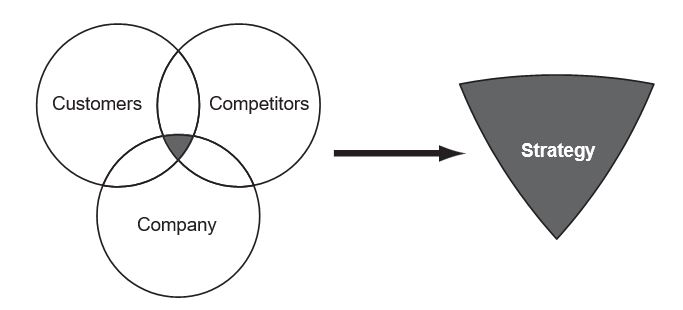Business Strategy and Persuasion
Insight from Persuading for Results.
“People don’t buy products or services; they buy SOLUTIONS to their problems.”
What is Strategy?
The word strategy is often misused and misunderstood. When we use the word we mean the simple definition used by the McKinsey consultant Kenichi Omhae: strategy is the intersection of three groups: customers, competitors and the company.
This simple definition helps when we talk with clients about complex issues that may or may not be strategic. Our quick mental check is 'does this involve customers and competitors as well as the company?' If it does not then it is not a strategic issue.
Strategy is all about gaining and sustaining competitive advantage over your competitors to win business from customers. However, the pace of business is accelerating and no organisation can build a competitive advantage that is sustainable. Shona Brown and Kathleen Eisenhardt, in Competing on the Edge suggest that the first rule of competing is, 'Advantage is only temporary'. Brown and Eisenhardt identify that different industries have a different pace, a different rhythm, while Jeffrey Williams suggests competitive advantage erodes at different paces for each different industry.
This evidence tells us we need to find ways of sustaining competitive advantages and building new advantages. Certainly, persuasion is more important in some industries than others. Persuasion is important where a company makes many presentations a year to win business or where a company makes a few presentations and these have high impact or high sales value for the company.
Customers and Competitors
Across all industries, customers are persuaded more by visuals and involvement in a presentation.
With improved technology and declines in price, even small companies can create presentations that are as impressive as those given by large companies. A more persuasive presentation will not give a company more capital or bigger facilities. However, it may persuade the customer to give them a chance. Malcolm Gladwell, in his book The Tipping Point describes how there is a point at which a small change can make a big difference. Perhaps a competitor now has the momentum to gain market share quickly.
What should you do? We suggest you experiment with some new presentation technology and experiment with potential alternative strategies for your business. Use the approach recommended by Shona Brown and Kathleen Eisenhardt and experiment with small, fast, low-cost trials of new technology. Try what Peter Sims calls 'Little Bets'.
No one knows exactly how technology will affect business strategy and the work of any presenter in the future. To get better at Persuading for Results, our advice is: for now, focus on building your skills and understanding the tools of persuasion; for the future, monitor your competitors, experiment with new technology and improve your persuasion skills.
“Most people don’t have the power of persuasion.”





